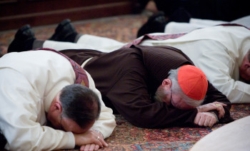Novena to Holy Spirit for abuse healing begins
SOUTH END— In the Cathedral of the Holy Cross, survivors of clerical sexual abuse gathered May 25, Ascension Thursday, with clergy, healing professionals and those offering emotional support, for the opening of the novena to the Holy Spirit a “Pilgrimage of Repentance and Hope.”
In May, Cardinal Seán P. O’Malley announced that on each of the nine days from Ascension Thursday to the Vigil of Pentecost that he would hold a Mass or prayer vigil at a different parish around the archdiocese that had been affected by clergy sexual abuse. The novena is scheduled to conclude Saturday June 3 with a procession from the chancery to St. Columbkille Parish in Brighton.
“Publicly acknowledging the Church’s faults and failures is an important element of asking forgiveness of those who have been harmed by the Church,” the cardinal said.
Before the Mass, the cardinal met with more than 20 members of his clergy for private contemplation in the cathedral’s Blessed Sacrament Chapel.
As the priests filed out of the chapel, they proceeded to sit in the pews with the congregants, rather than on the chairs set up on the altar for the Mass’s introductory rites.
Individuals got up from their seats to allow priests to sit in the front or together, but the priests gestured for them to sit down. “No, no don’t get up,” said one. “Sit right there, I’ll sit here,” said another.
Father John J. Connolly, the cathedral rector, began the evening’s program by climbing up into the pulpit and introducing Olan Horne, a victim of clergy sexual abuse who was invited to share his perspective. “His own journey has had its ups and downs,” he said.
Father Connolly said since the revelation of the scandal, Horne has become an important part of the healing process. “He is someone who has become my good friend,” he added.
“Why me?” Horne asked. “It wasn’t any easy choice for me to be here,”
“There is a conflict between what I need to say and what I need to do. It is an opportunity, an obligation and responsibility,” he said. “So, that is why I am here.”
“I would be happier the day I can stand on the altar for the heart,” he said. “But what do you do with an opportunity? We take advantage of it.”
“My mentors, who were great men, were great Catholics,” he said. By speaking at the novena, Horne was honoring them, he said.
Horne said he was grateful to the cardinal for making the effort to reach out to the survivor community. “I read in the paper, someone said, ‘I thought this was over.’”
It is difficult for him to go into the parishes and share his experiences, Horne said. “They ask me, ‘Why come here if you are not a Catholic?’”
He said, “I am not trying to change the Church, I am trying to deal with this issue. Can we stand up together and say it was wrong?”
Then looking straight at the archbishop he said, “I thank you for this beginning, today.”
“Now is the time. I speak for many people, dear friends—some departed. The bad news is I have received compensation from the Church,” said Horne. “But, what we need is restoration.”
After Horne returned to his seat behind the altar, the cardinal and clergy rose from the pews and in three rows laid prostrate before the people of God, while a litany of repentance, listing 30 specific sins and failings was sung. Some priests buried their face in their hands, most had their face straight down with arms to their sides. One read along as the cantor called out each line.
“I have never seen anything like it,” said Sister Anthony Mary Diago, RSM, a member of the cathedral staff.
Sister Anthony Mary said she did not know what to expect when she arrived. It was the first time she saw priests prostrate except for an ordination. “It was a humble and moving gesture,” she said.
Outside the service, protesters, such as James J. Sullivan Jr., continued to challenge the Church’s response to the scandal. “I am just a concerned and outraged Catholic,” he said.
“We are not taking action steps,” he said. “I am appalled that the Church is not backing the proposal to extend the statue of limitations for sexual abuse.”
After the service, Horne said he knows all of the protesters outside and he understands what they are trying to do. “They have the right to be there.”
When he greeted the priests who came over to him, Horne was the one who asked how they were doing. One priest told him he was having a tough time and Horne told him it was OK. “If it doesn’t work today. There is always tomorrow,” he said.
<



















